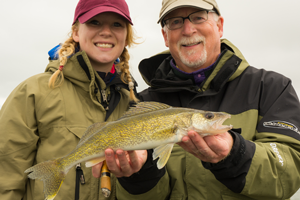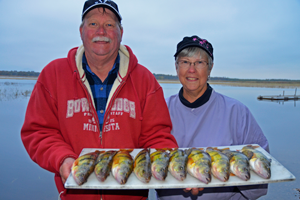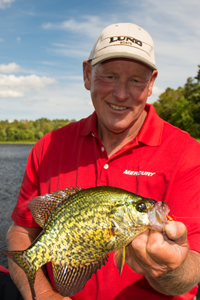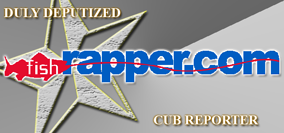
 Fishing Article: A “Bright Outlook” For Leech Lake This Walleye Opener - Jeff Sundin
Fishing Article: A “Bright Outlook” For Leech Lake This Walleye Opener - Jeff Sundin
If you took a poll among die hard walleye anglers that asked about their preferences for ideal fishing weather, I doubt that you’d find many of them hoping for the forecast that I just looked at. The NOAA forecast for Saturday on Leech Lake are Bluebird skies, warm temperatures and not much wind; YUK.
Still, it might feel nice to spend a fishing opener under old Sol and not under the hood of a winter parka.
Ideal fishing weather or not, all indicators point to the presence of Walleyes in good numbers. By all accounts, anglers should feel confident about the potential for a very good opener on the big lake next weekend.
The 2016 population assessment of Walleye on Leech Lake is not yet available. But results from the 2015 assessment show a catch rate of 12.40 fish per test net. While those were not record setting numbers, they do fall well into the higher end of a 20 year average. In fact, from 1983 thru 2015 the average catch is 7.9 fish per net. The 2015 catch rate of 12.4 represents the third highest catch rate in the time series and topped the 7.9 fish average for the 9th consecutive year.
Walleye size structure is well balanced according the DNR report on the size distribution of the sampled fish; Walleye sampled in gillnets ranged in length from 7 to 26 inches. The average lengths of age-1 walleye were 9.9 inches, at age 2, 12.2 inches and by age 4, Walleye grow to 16.9 inches on average.
That’s excellent news for Walleye fishermen because solid 2011, 2012 and 2013 year classes will provide harvestable fish during 2017 and throughout the next several seasons.
Trophy hunters will appreciate that 24% of walleye sampled in gillnets were between 20 and 26 inches. Although fish in the 20-26 protected slot will certainly provide anglers the opportunity to catch a larger fish, there does appear to be a shortage of really large fish. The proportion of fish above 26 inches sampled in gillnets was very low, only .5% of the sample represented fish between 26 and 29 inches. Additionally, there were no fish over 29 inches captured during the 2015 survey season.
 That doesn’t mean nobody will catch a trophy Walleye this season, but it does support the idea that fish in the protected slot range do tend to stack up. Whether anglers harvest the fish after they grow to “legal size” or if the fish limit themselves by consuming too much food is uncertain. The scenario is not unique to Leech Lake though and around the state, studies are ongoing to determine the cause(s) of this stacking effect.
That doesn’t mean nobody will catch a trophy Walleye this season, but it does support the idea that fish in the protected slot range do tend to stack up. Whether anglers harvest the fish after they grow to “legal size” or if the fish limit themselves by consuming too much food is uncertain. The scenario is not unique to Leech Lake though and around the state, studies are ongoing to determine the cause(s) of this stacking effect.
Without a crystal ball, it's hard to say a lot more about the Walleye outlook on Leech, but all things considered, I'm very optimistic about the upcoming Walleye season.
Perch on the hand are a different story. Both catch rates and size structures are seriously declining in the big lake. Once known as a preferred lake for catching monster size Perch, fish of quality size are fast becoming scarce as hens teeth. Whether it ’s angling pressure, predation by the larger population of Walleye or from some other natural cause, opportunities to harvest good numbers of big Perch are fewer now than ever before.
Gillnet catch rates of yellow perch have ranged from 12.1 fish per net in 2013 to 37.7 fish per net in 1995. The 2015 catch rate of 18.6 fish per net remains below the long term average of 21.1 fish per net but did represent an increase from the record low of 12.1 fish per net observed in 2013.
Yellow perch sampled in 2015 gillnet sets ranged in length from 3 to 12 inches. But of the total perch caught only 24% were longer than 8 inches and only 6% were 10 inches and longer; that does not bode well for Perch fishermen on Leech this season.
Of course just because Perch populations are low, doesn’t mean that we won’t catch any this season, but on the heels of record harvests that occurred just a few years ago, it’s going to seem pretty slow.
 The decision about how many Perch to harvest is a personal one and I know that it's not easy to choose releasing really big Perch. But it's an idea that needs to be explored because the few jumbos that remain in the system could help speed up a recovery. Perch are highly cannibalistic, and it would be nice if we could count on some of the larger ones to help control the population of smaller ones. That way we could possibly avoid going through a period where the lake becomes filled with little ones that never seem to achieve harvestable size.
The decision about how many Perch to harvest is a personal one and I know that it's not easy to choose releasing really big Perch. But it's an idea that needs to be explored because the few jumbos that remain in the system could help speed up a recovery. Perch are highly cannibalistic, and it would be nice if we could count on some of the larger ones to help control the population of smaller ones. That way we could possibly avoid going through a period where the lake becomes filled with little ones that never seem to achieve harvestable size.
Harvesting fish for the table will be made easier by a stable population of Northern Pike. The 2015 gillnet catch rate of northern pike was 5.9 fish test net which represents an above average capture rate. In fact, it’s nearly equal to the 20 year high of 6.2 fish per net that occurred in 1995.
Among Pike anglers, Leech Lake has not been known as a “big fish” destination. But it is known for supplying good numbers of decent size fish for eating. Current numbers bear that out as over 60% of the fish captured during nesting exceeded 20 inches in length. Of those, only 22% were larger than 25 inches and there were no fish larger than 30 inches captured.
That means an average fish for eating will stretch the tape at around 22 to 24 inches, not huge, but respectable for filleting and definitely delicious to eat.
Crappie anglers should continue to have good luck too. Catch rates were higher in 2015 9 fish per hour than they were in 2012 at 5 fish per hour. Catch rates for fish 10 inches were similar between 2015 5 fish per hour and 2012 4 fish per hour. Length and age frequency distributions of black crappie sampled in 2015 ranged from 2 to 14 inches and 1 to 12 years, respectively. Of all black crappie sampled in 2015, 62% were 10 inches or longer.
There should be an ample supply of these fish remaining in the system to allow plenty of opportunity during the 2017 season.
Zebra Mussels or at least a pair of positive tests for them have appeared on the scene at Leech Lake. So here’s one final note about the upcoming season on Leech Lake. Even though the spread of the Zeebs appears to be inevitable, slowing down the distribution of them still has value.
So far, only 2% of the lakes in Minnesota have them and that means we have time to figure out some ways of winning the battle.
Do your best to keep your rig cleaned up and I will too and just between us two, we can keep it from spreading to wherever we fish this summer. If we each get one buddy on board and each of them gets one of their buddies on board … you get the idea.
Wherever you go this weekend, have a fabulous opener and who knows, we may even wind up fishing the same honey hole!
 Join And Become A Duly Deputized Fishrapper Cub Reporter
Join And Become A Duly Deputized Fishrapper Cub Reporter
Helping your fellow fishermen and women stay abreast of the fishing conditions in your area is good for everyone and it's easier than you think!
Fishing Reports Minnesota is the Facebook counterpart to this page and it's open to the public. Be like me, become a duly deputized "Cub Reporter" and post your own pics and comments. If it's good for fishing, then it's Good For Everybody!